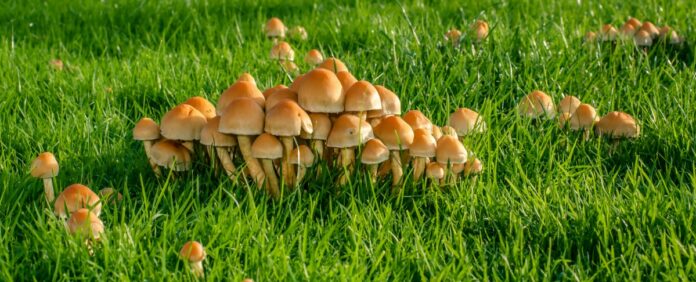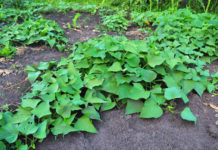Lawn mushroom species are a fascinating and mysterious phenomenon that has captured the attention of gardeners, nature enthusiasts, and foodies alike. They are a diverse group of fungi that can range in size, shape, and color, and they can grow in a variety of different environments, from the dark, damp corners of a shaded garden to the sunlit meadows of a suburban lawn. In this article, we will explore the world of backyard mushrooms, answering questions like “What Are Backyard Mushrooms?” and “Why Do Mushrooms Grow in Backyards?” We’ll also take a closer look at some of the most common lawn mushroom species and offer tips for identifying them.
What Are Backyard Mushrooms?
Backyard mushrooms are a diverse group of fungi that can grow in the yards and gardens of homes across the world. They are part of the kingdom of Fungi, which also includes yeasts, molds, and other types of fungi. Mushrooms are the fruiting bodies of fungi, which means that they are part of the fungus that produces spores, which are used for reproduction. While the mushroom itself is often what people notice, the actual fungus may be growing underground or within decaying wood or other organic matter.
Why Do Mushrooms Grow in Backyards?
Mushrooms grow in backyards for a variety of reasons:
- Organic Matter: The most important factor is the presence of an environment rich in organic matter. Fungi are decomposers, which means that they break down dead plant and animal material, recycling nutrients back into the soil. A backyard that is rich in decaying wood, leaves, and other organic matter provides the perfect habitat for fungi to thrive.
- Sheltered or protected Spaces: Another important factor is the presence of shady, sheltered, or protected spaces. Many backyard mushrooms prefer to grow in areas that are protected from direct sunlight, such as under trees or in the corners of a shaded garden. They may also prefer areas that are sheltered from the wind or other environmental factors that could dry them out or damage their delicate fruiting bodies.
- Damp and humid conditions: Finally, mushrooms require damp, humid conditions to grow. They need moisture to survive, so they are more likely to appear in backyards that are prone to dampness or that receive regular rainfall. In some cases, backyard mushrooms may even grow in areas that are prone to flooding or standing water.
Why Do I Have Mushrooms Growing in my Yard?
If you have mushrooms growing in your yard, it is likely due to one or more of the factors we’ve discussed. Your yard may have a lot of organic matter, such as dead leaves, wood chips, or decaying logs, that provide a rich habitat for fungi to thrive. You may also have areas of your yard that are shaded or protected from the elements, such as under trees or in the corners of a garden. Finally, if your yard is prone to dampness or receives regular rainfall, it may be a prime location for mushroom growth.
It is worth noting that while backyard mushrooms are generally harmless, there are some species that can be toxic or cause allergic reactions in humans or pets. As a general rule, it is best to avoid eating any mushrooms that you find in your backyard unless you are an experienced forager or have consulted with a knowledgeable expert.
Common lawn mushroom species:
If you’re an avid gardener or nature enthusiast, chances are you’ve encountered some mysterious mushrooms sprouting up in your backyard. While they can be fascinating to observe, it’s important to exercise caution when handling or consuming backyard mushrooms, as some species can be toxic or cause allergic reactions in humans or pets.
Ringless Honey Mushroom (Armillaria Tabescens)
The Ringless Honey Mushroom is a common backyard mushroom that can be found growing on the roots and stumps of trees. It has a honey-colored cap and a white stem, and can be recognized by the lack of a ring around the stem. While it is not toxic to humans, the Ringless Honey Mushroom is considered a parasite and can cause damage to the trees it grows on.
Common Stinkhorn (Phallus Impudicus)
As its name suggests, the Common Stinkhorn is known for its foul odor, which is often described as smelling like rotting meat or garbage. It has a tall, phallic shape and a brown or reddish cap, and can be found growing in damp, shady areas of the backyard. While it is not toxic, the Common Stinkhorn is not typically used for culinary purposes due to its strong odor.
Field or Meadow Mushroom (Agaricus Campestris)
The Field or Meadow Mushroom is a popular edible mushroom that can be found growing in grassy areas of the backyard. It has a white or tan cap and a thick stem, and can be recognized by the pink gills underneath the cap. While it is considered safe to eat, it is important to properly identify the Field or Meadow Mushroom before consuming, as it can be mistaken for toxic lookalikes.
Shaggy Ink Cap (Coprinus Comatus)
The Shaggy Ink Cap is a distinctive mushroom with a tall, shaggy cap and a delicate stem. It can be found growing in damp, shaded areas of the backyard, and is known for its unusual lifecycle. When the cap begins to mature, it begins to dissolve into a black, inky substance, giving the mushroom its common name. While it is safe to eat when fresh, the Shaggy Ink Cap can cause a toxic reaction if consumed with alcohol.
Mower’s Mushrooms (Panaeolus Foenisecii)
Mower’s Mushrooms are small, brown mushrooms that are commonly found in lawns and other grassy areas of the backyard. They can be recognized by their cone-shaped caps and thin stems, and are typically considered harmless to humans and pets. However, they can cause allergic reactions in some people.
Fairy Ring Mushroom (Marasmius Oreades)
The Fairy Ring Mushroom is named for the circle-shaped pattern it often forms in the grassy areas of the backyard. It has a small, tan cap and a thin stem, and is considered safe to eat when cooked. However, it can be difficult to properly identify the Fairy Ring Mushroom, as it can be easily confused with toxic lookalikes.
Fly Agaric (Amanita Muscaria)
The Fly Agaric is a bright red mushroom with white spots on its cap, making it one of the most recognizable backyard mushrooms. It contains a potent toxin called muscimol, which can cause hallucinations, delirium, and other serious health problems. Despite its toxicity, the Fly Agaric has been used in traditional medicine and religious rituals for centuries. In fact, it is said to have been a favorite of Vikings, who would consume it before going into battle to induce a sense of fearlessness.
Green-Spored Parasol (Chlorophyllum Molybdites)
The Green-Spored Parasol is a large, white mushroom that can be found growing in lawns and other grassy areas of the backyard. It contains a toxin called chlorophyllin, which can cause severe gastrointestinal symptoms such as nausea, vomiting, and diarrhea. While it is not typically fatal, consuming the Green-Spored Parasol can be a very unpleasant experience.
Giant Puffball (Calvatia Gigantea)
The Giant Puffball is a large, white mushroom that can grow up to a foot in diameter. It can be found growing in grassy areas of the backyard and is prized by mushroom hunters for its delicious flavor and meaty texture. To prepare the Giant Puffball for consumption, simply cut it into slices and cook it like a steak. It can also be used in soups, stews, and other dishes.
How to know if the lawn mushroom species is poisonous?
Mushrooms are fascinating organisms that can be both beneficial and harmful. While some backyard mushrooms are edible and delicious, others can be toxic and even deadly. So, how do you tell if the mushrooms growing in your backyard are poisonous? Here are some tips to help you identify dangerous backyard mushrooms:
- Learn to identify poisonous mushrooms: The first step to preventing accidental poisoning is to learn to identify the dangerous species. Familiarize yourself with the common poisonous mushrooms in your area and avoid eating any mushrooms that you are not absolutely certain are safe.
- Check for telltale signs of poisonous mushrooms: Poisonous mushrooms often have distinctive features such as a cap with warts or scales, a veil or ring on the stem, or a distinctive odor. Check for these features before consuming any mushroom.
- Consult a mushroom expert: If you are not confident in your ability to identify mushrooms, seek the advice of a local mushroom expert or mycologist. They can help you identify species and determine which ones are safe to eat.
- Avoid mushrooms growing on dead or decaying wood: Many poisonous mushrooms, such as the deadly Galerina and Conocybe species, grow on dead or decaying wood. Avoid eating any mushrooms growing on wood.
- Look for mushrooms growing in groups or clusters: Many poisonous mushrooms, such as the deadly Amanita phalloides or “Death Cap” mushroom, grow in clusters or “fairy rings.” If you see mushrooms growing in this pattern, stay away from them.
- Avoid mushrooms with white gills: Many poisonous mushrooms have white gills, while edible mushrooms typically have pink or brown gills. Be cautious of any mushrooms with white gills.
- Check the spore print: Collect a mushroom cap and place it on a sheet of paper, gill side down. Cover it with a bowl and leave it for several hours or overnight. The spores will drop onto the paper, and you can examine the color to help identify the species. Some spore prints are poisonous or carcinogenic, so handle with care.
- Don’t rely on taste: Many poisonous mushrooms can taste good and even be delicious. Do not rely on taste to determine if a mushroom is safe to eat.
- Side of caution: If you are unsure about the safety of a mushroom, do not eat it. It is better to be safe than sorry.
How to get rid of unwanted Lawn mushroom Species?
Mushrooms can add an interesting touch of nature to your backyard, but if you want to avoid unwanted or potentially poisonous species, it’s important to take measures to prevent their growth. Here are nine effective ways to prevent mushrooms from growing in your backyard:
- Increase light and air circulation: Mushrooms thrive in moist and shaded areas, so increasing the amount of light and air circulation in your backyard can help to prevent their growth.
- Improve soil drainage: Poor soil drainage can create the damp conditions that mushrooms love. To prevent this, make sure that your backyard has good drainage by adding organic matter or sand to the soil.
- Limit irrigation: Overwatering your lawn or garden can create the moist conditions that mushrooms need to grow. Water your plants only when necessary, and make sure that the soil has a chance to dry out between watering sessions.
- Remove wood and tree stumps: Dead wood and tree stumps are a prime breeding ground for mushrooms. If you have any dead wood or stumps in your backyard, remove them to prevent the growth of mushrooms.
- Remove excess thatch in lawns: Thatch is the layer of dead grass and plant material that accumulates on the surface of lawns. Excessive thatch can create the damp conditions that mushrooms love, so it’s important to remove it regularly.
- Remove immature mushrooms: If you spot any mushrooms in your backyard, remove them before they have a chance to mature and release their spores, which can lead to further growth.
- Balance the bacteria and fungi in your soil: Creating a healthy balance of bacteria and fungi in your soil can help to prevent the growth of unwanted mushrooms. Adding compost or other organic matter to your soil can help to achieve this balance.
- Apply a nitrogen-rich fertilizer: Nitrogen is an essential nutrient for many types of plants, but it can also help to prevent the growth of mushrooms. Applying a nitrogen-rich fertilizer to your lawn or garden can help to create an environment that is less conducive to mushroom growth.
- Use natural ways to kill mushrooms: If you already have mushrooms growing in your backyard, there are several natural ways to kill them. Sprinkling baking soda or vinegar on the affected area can help to kill the mushrooms, while a solution of soapy water can help to prevent their growth.
Frequently Asked Questions (FAQs):
What lawn mushroom species is common in India?
The button mushroom (Agaricus bisporus) is the most common mushroom species in India, and it is widely cultivated and consumed.
What is the most common lawn mushroom?
The most common lawn mushroom is likely the fairy ring mushroom (Marasmius oreades), which forms distinctive rings in lawns and other grassy areas.
Which is an edible mushroom species?
Many mushroom species are edible, but some of the most commonly consumed include the button mushroom, shiitake mushroom, oyster mushroom, and portobello mushroom.
Can all backyard mushrooms be eaten?
No, not all backyard mushrooms are safe to eat. Some species are poisonous and can cause serious illness or even death if consumed. It’s important to properly identify any mushrooms before consuming them.
How do I identify a mushroom species?
Identifying mushroom species can be tricky and should only be done by those with experience and knowledge. There are many resources available, including field guides, online forums, and local mycological societies, that can help with identification. It’s important to always stay on the side of caution and avoid consuming any mushrooms if you’re unsure of their identity.

















